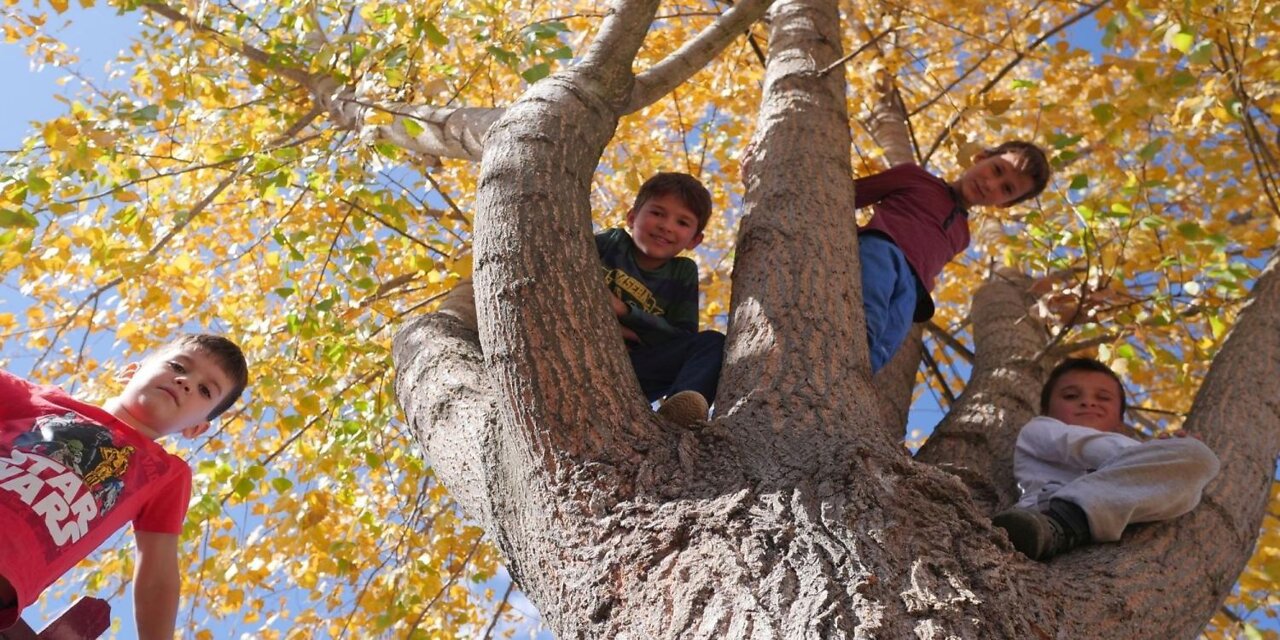Premium Only Content

Filmul Scrum - Povestea Văii Screzii, Prezentare: George Ogararu
Filmul Scrum - Povestea Văii Screzii - Prezentare – George Ogararu
Copii care vin de la şcoală, coborând dealurile pe „cântec” de talangă.
Copii care merg la şcoală, deşi n-ar fi trebuit să existe - ce minune! Copii care râd, aleargă, fac năzbâtii puerile împreună, deşi copilăria lor stă sub semnul abandonului, al refuzului, al stigmei.
Bătrâni suferinzi, cu picioarele amputate, cu boli incurabile, pe care România i-a condamnat de mult la însingurare, la ostracism.
Mame mult prea tinere, care îşi adorm şi îşi alină singure copilul, nu alături de bărbatul cu care l-au făcut.
Valea Screzii e despre toate acestea şi încă multe, multe altele. E despre credinţă. Credinţa fierbinte a unui om atins de îngeri, părintele Nicolae Tănase, că orice fiinţă pe care o laşi în urmă, orice seamăn pe care îl omori fizic sau spiritual prin renunţare, este o urâciune în faţa lui Dumnezeu.
Valea Screzii e despre speranţă. Speranţa că acolo unde există credinţă şi oameni, Dumnezeu e omniprezent, iar toate celelalte vor veni.
Inspirat de exemplul de slujire al părintelui Gheorghe Calciu Dumitreasa, profesorul său la Seminarul Teologic din Bucureşti, părintele Nicolae Tănase a creat în Valea Screzii un fenomen social, o utopie dintre cele mai frumoase: o serie de aşezăminte sociale pentru “oile pierdute” ale societăţii româneşti: orfani, copii părăsiţi sau cu părinţii plecaţi la muncă în străinătate, bătrâni afectaţi de suferinţe fizice şi psihice, pe care sistemul de stat îi respinge, ca pe un corp străin.
Valea Screzii îi ţine României oglinda: oglinda neputinţei şi oglinda posibilităţii.
Copiii din Valea Screzii nu au multe: dar se au unii pe alţii, şi îl au pe părintele Tănase. Cu un astfel de înger păzitor, cum ai putea să te temi de singurătate, de lipsuri, de viitor?
Valea Screzii este o minune. Pentru că aici, Dumnezeu lucrează prin oameni. Prin zecile de voluntari tăcuţi, care asigură bunul mers al complexului social şi le oferă ocupanţilor săi şansa la o masă caldă, la educaţie, la tratament medical, dar mai ales la comuniune. Prin miile de filantropi care au sprijinit munca părintelui Tănase, din 1994 încoace.
Acum, a venit timpul ca voi să ieşiţi din umbră, din neştiinţă, şi să ajutaţi.
Fiţi voluntari pentru copiii şi bătrânii din Valea Screzii. Ajutaţi mamele locului să îşi găsească făgaşul, după ce viaţa era să le arunce pentru totdeauna de pe el.
În 2020, SCRUM va imortaliza povestea Văii Screzii, a învingătorilor de aici şi a îngerilor gardieni care îi ajută. În 2020, spectacolul Vieţii, al Durerii, al Izbânzii care se derulează aici zi de zi trebuie să fie cunoscut de lumea întreagă.
25% din încasările filmului vor ajunge la ORFANII şi bătrânii ABANDONAŢI din Valea Screzii!
Cronologie
Poate că imaginile fac cât mii de cuvinte, însă lacrimile și victoriile mărunte - în realitate, imense - ale unor suflete părăsite, sunt dincolo de orice descriere posibilă. Fiecare zi petrecută în Valea Screzii este o bătălie cu o soartă care nu face favoruri. De aici se ridică învingătorii, aici se călește spiritul, aici se testează tăria.
Videoclipul alaturat, în care apar celebrităţi precum George Ogăraru - unul dintre oamenii care au ajutat Valea Screzii şi Valea Plopului - şi omul de la care a plecat totul, părintele Nicolae Tănase, vrea să convingă oamenii să vină alături de noi.
Clipul nostru vă introduce în atmosfera din Valea Screzii, folosind imagini de arhivă realizate timp de 20 de ani de către Cristi Dinu, un localnic stabilit aici în 1997, ca ajutor al Părintelui Nicolae Tănase. Un pictor de icoane devenit cameraman și editor video, Cristi a documentat drama sfâșietoare a screzenilor, în peste 340 de ore de filmare. Noi vă oferim 5 minute cât o eternitate.
Ambasadori
Suntem o echipă mică, iar orice vot de încredere contează. Îți mulțumim pentru alegerea de a distribui povestea filmului SCRUM şi de a fi ambasadorul proiectului! Te poți abona la newsletter sau urmăreşte evoluţia proiectului pe scrumfilmul.ro şi pe canalele noastre de socializare.
Regizorul Andrei Negoiţă Zagorodnâi - Filmul SCRUM - Aşezămintele de la Valea Plopului
https://rumble.com/v1h997x-regizorul-andrei-negoi-zagorodni-filmul-scrum-aezmintele-de-la-valea-plopul.html
Povestea Locului, Valea Screzii, Valea Plangerii (Website-Ul Este Bilingv) - Teaser Scrum 25 min RO/ENG
www.scrumfilmul.ro
www.nothingbutashes.net
Alte Legaturi utile:
Regizorul Andrei Negoiţă Zagorodnâi - Filmul Scrum - Povestea minunii de la Valea Screzii
https://rumble.com/v1h9b7l-regizorul-andrei-negoi-zagorodni-filmul-scrum-povestea-minunii-de-la-valea-.html
Regizorul Andrei Negoiţă Zagorodnâi – Filmul “7 CUVINTE, Viata unui biruitor”
https://rumble.com/v1h9dix-regizorul-andrei-negoi-zagorodni-filmul-7-cuvinte-viata-unui-biruitor.html
__________________________________________________
The Life’s Work Of Fr. Nicolae Tanase, A Romanian Priest
When the Romanian revolution took place in December of 1989, Fr Nicolae Tanase had been the rector of the Valea Plopului village church located in the Posesti Commune of Prahova County for ten years. He continues to serve there to this day. Here in Valea Plopului, during the darkest hour of the communist regime, he was able to build a church to replace the old one destroyed by the earthquake of 1977. During that period, it was practically impossible to obtain a building permit for the construction of a place of worship. Since they did not have one, the community built it by night. Every villager contributed to its construction. As a result, the community of believers grew and was strengthened so much that it was able to assist its priest during the post-revolutionary years in his fight for the future of those who found themselves unwanted, betrayed, and forsaken.
During a blizzard in January 1990, Fr. Nicolae Tanase was driving all night for a few hundred kilometers to pick up an abandoned newborn baby. He returned to his village with a cardboard box containing a bundled up child. He placed him in the warmest corner of the church and began serving the Divine Liturgy, since it was a Memorial Saturday. As soon as the baby would begin crying, the parish women would immediatley flock to pick him up, soothing the baby and taking turns holding him. By the end of the Liturgy, the baby ended up in the hands of one of the local residents named Maria. The priest asked her if she would be willing to take care of the baby. Afterward Maria shared that she took this request as a sign from God. The baby boy was baptized with the name of Lucian and grew up in Maria and her husband’s family together with their five children. Lucian currently resides in Valea Plopului in his own home and a third baby is about to be born while his father is away working, supporting his family as a migrant laborer in Italy.
The most vital task for the overall good of Romania
Without a construction permit, they built it by night. Every villager contributed to its construction. A community of believers was born.
On December 26, 1989, one of the articles in the first decree signed into law by the new rulers of Romania immediately after the dictator Ceausescu’s attempt to flee eliminated bans on
abortions
of up to three months of gestation. It was done in such haste because it was necessary to underscore a newly minted myth of freshly won freedoms, as if the communist regime allegedly prohibited abortions, and so their legalization was deemed a testimony to the fall of communism. However, historical reality paints quite a different picture: the communists legalized the termination of pregnancy in 1957 to have it formally banned only in 1966, although that had not prevented millions of abortions. Statistical data is the proof and confirms that from 1966 to 1989, state medical facilities have exclusively performed almost 7.5 million abortions, which is practically the same amount as between 1957 and 1966. The ban was introduced due to demographic and economical reasons, not because society had realized the value of the life of children and women. In 1965, the year preceding the ban, the state registered 1.115 million aborted unborn children and only 278,362 live births. At 252 per thousand women, Romania’s abortion rate was considered the highest ever registered in the world.
Romania happened to have the highest abortion rate per thousand of women ever registered in the world
As a consequence of the decree issued in December 1989, 5 million abortions were performed in state medical facilities during the first eight years following the Romanian revolt. This data does not take into account the great number of unrecorded willful interruptions of pregnancy performed in inadequate facilities by either professional medical specialists or unqualified personnel as described by Dr. Ancuta Elena Frantz of Iasi, Alexandru Ioan Cuza University, in a specialized journal, “Acta Universitatis ‘George Bacovia’. Juridica” (2/2014).
Realizing the tragedy of the situation, jointly and with the initiative of the Christian poet Ioan Alexandruii, Fr. Nicolae Tanase founded a movement called, “Saving Lives—Pro Vita Brancoveanu.” Righteous Hospodar Constantine Brancoveanuiii was to become a spiritual guardian of the new movement since he was known for having a large family of eleven children. Priest Nicolae Tanase is convinced that the demographic policies of the Hospodar-martyr were the main reason why he was dethroned. He also firmly believes that the demographic growth in the client states is not up to an empires’ liking, just as pharaoh did not particularly enjoy seeing the Jewish tribes grow and multiply in Egypt. “Brancoveanu increased the number of our people using his personal life as an example, in addition to lowering taxes and creating favorable conditions for the living of ordinary people,” insists Fr. Nicolae.
It takes a lot of time to save a man
Fr. Nicolae TanaseFr. Nicolae TanaseOn Mondays, Wednesdays, and Fridays, the priest and a poet held prayer vigils before the tomb of Brancoveanu in New St. George Church located by the Ground Zero in Bucharest, and spend the rest of the day visiting hospitals and persuading women to forego abortion. They would even attempt to reach out to those who already paid for it. “Once, for example, we were able to save thirteen babies during just one day,” recalls Fr. Nicolae.
Life is what needs to be saved. However, even such a life-saving act is incomplete if taken on its own and without attending to the fact that every new baby has to grow in a healthy and protected environment in addition to being nurtured well. It became obvious that long-term support was needed, including first and foremost a place to shelter mothers with newborns saved from abortion.
A moment arrived when the priest had once again called upon his small parish community’s sense of solidarity formed during the communist era. “Two days and one night had passed before we were able to find homes for the first thirteen babies, for we only had one church and no social care facilities,” he shares. Soon, after a short while, another ten were given homes among the local families. An extra mouth to feed did not feel like a heavy burden to those kind souls and the children received a traditional upbringing in their families in the company of children of their same age. The fellow villagers eagerly rose to their priest’s call.
It became obvious that long-term support was needed, including a place to shelter mothers with their newborns
To assist the community, volunteers began to come in, first from abroad, where the culture of volunteering was more developed, and later from Romania. “Our first volunteers were Dieter and Christine Pohlheim, a married couple from Switzerland who in 1993 spent the first year of married life in the company of our children,” reminisces Fr. Nicolae.
In 1994, different families in Valea Plopului hosted 86 socially vulnerable people, primarily children. It was also when the first homes for the asylum were built, as the number of those in need grew and the priest could not turn anyone away. The new construction certainly did not match any official construction standards, but at least father could offer shelter to those in distress. “According to those standards, the rooms had to have ceilings 2.4 meters high, a certain level of sun exposure, tiled floors, etc. But we hastily needed to resettle the homeless children who would otherwise be shacked up in an abandoned canaliv. We could not leave them there waiting till everything was built by the state standards,” he adds.
Today, the priest notes with satisfaction how a legal framework has developed post-2007; and, according to Chapter 67 of the Regulations on the organization and functioning of the Romanian Orthodox Church, the parishes have the right to freely conduct social and humanitarian work. It allowed the parish in Valea Plopului to establish the “Pro Vita” Parochial Social Center hosting over 400 residents, which includes children, single women, either homeless or victims of domestic abuse, and elders. Conversely, counting from 1990 up to the present, the local parish was able to give refuge, provide food and clothing, and offer solace and spiritual guidance to over 3500 souls.
Beginning from 1990 up to present, the parish has given refuge, provided food and clothing, and offered solace to over 3500 souls
Their needs are great. To feed everyone, they use no less than 1000 loaves of bread daily. Free camps are offered for young children over the summer break. His Beatitude Daniel, Patriarch of Romania, used his own money to cover the cost of six summer break sessions in the camps along the Black Sea Coast for almost a hundred Valea Plopului kids with vitamin D deficiency.
The project not only supports the children but it also offers career guidance. Depending on their inclination, be it hands-on activities or creative work, they learn such skills as painting on glass, woodwork and wood-cutting, timber housing, sewing, as well as the domesticities (livestock care, fieldwork, and bread baking). The center is partly financed by revenue from selling handicrafts, although the money primarily comes from donations by major benefactors or is collected through various fundraising campaigns. Gheorghe Ogararuv, the football player, and his wife Andrea, together with their five children, offer help, too. Because they adhere to the values of having a nuclear family, they occasionally get involved in campaigns that benefit the social services center.
When he was asked how his own family came to terms with his charity workload, the priest responded in all sincerity, “I disregarded the former to benefit the latter.” Great is the merit of his matushka who carried her cross alongside him. The priest who has his own six children, including one adopted child, and twenty grandchildren, thinks that the salvation of their nation lies in the hands of women as they give birth to new life: “The empires fell when there were no mothers left. This is the key to the future of any nation.” Men however do carry an immense responsibility for the protection of mothers. According to Fr. Nicolae’s estimate, 80 percent of abortions happen because of the vices of men “who empty women’s souls.”
According to Fr. Nicolae’s estimate, 80 percent of abortions happen because of the vices of men who “empty women’s souls.”
“There is a catchphrase: ‘We want to have a baby but we are not ready to have him right now’. ” That is how father quotes those who justify their right to abortion.
“But they forget that a child is a coauthorship of the threesome: the father, mother, and God. The father offers semen, the mother provides ovum, and God adds the soul. One sperm cell out of approximately four million inseminates the only cell released in the woman’s body: there is no greater miracle than this!” he speaks about the miracle of the conception of human life.
Recognition of life as a miracle and acceptance of having a family as a sacrifice are two key questions.
A child’s soul is alive from the very beginning when just one cell is born, born from parents’ offerings, along with the gift from God. Therefore, the realization of life as a miracle and acceptance of family as a sacrifice are essentially the most important issues that compel us to procreate.
Once you make an effort, you gain your strength back
Fr. Nicolae Tanase speaks succinctly, bluntly, and straightforwardly, without mincing any words. He may sound almost rough and heavy-handed, hitting you with words like with a club; but as if with a sword he sunders the pure water of truth and love of neighbor from the muddiness that contaminates the spring. It so happens that when you ask him for advice, his answer may prove to be too unmerciful for you. But if you listen patiently, you will benefit from it and gain spiritual wisdom, especially if he shares some real-life stories. Here is one of them.
“There was once a priest who never went on a vacation,” father begins his story. “When he finally was able to go on vacation, an abbess of a monastery called for him to come and help dissuade a young woman from having an abortion. The priest came and spent nineteen days in that monastery. By night he would hold conversations with that girl, and during the day she went to work and the priest rested. However, during the day, her aunt, instigated by an evil spirit, destroyed all the good the priest was able to sow in the heart of that girl during their nightly vigils. The priest and the girl left the monastery on the same day by the same train. She got off at the station in a town where her aunt had made an appointment for her abortion, while the grieving priest continued further on. His sorrow was so great that he never visited that monastery again during the next nine years. But once, during one freezing winter night, he had no other option but to stay overnight at that monastery. He spent a night there and in the morning he went to church to serve the Liturgy. The abbess asked him why he has not visited them for such a long time. “Because it saddened me that I failed to persuade that girl…” “It is not true, father! Come and have a look here!” the abbess summoned him. Just on that day, that same young woman came to the monastery as if by chance, but this time she arrived with her nine-year-old daughter. “What happened to you? Didn’t you leave the train deciding otherwise?” asked the priest. The woman told him how she at first had climbed into the examination chair to have the procedure and how she was given local anesthesia. But when a doctor came, she all of a sudden jumped from the chair in an attempt to flee. The assisting nurse slapped her face twice to bring her back to senses and then helped her back up on the chair. She jumped off the chair again and started screaming so that the doctor withdrew from performing the procedure on her. The young woman walked out of the hospital anesthetized, by holding on to the walls. She saved her baby’s life.”
It was one of the wonders performed by God, the miracle that provides joy to our tireless mission that we can be called to do at any moment. When not a shadow of hope is left but a man makes an effort of will, God accommodates it. Lord, give us the will to do good, and may it be what You desire!
The anti-Communist uprising in Romania on December 16-26, 1989 that ended in the overthrow of the regime of the country’s president Nicolae Ceausescu.
* Gheorghe Ogararu is a well-known retired Romanian football player who played for “Steaua București” football club, “Ajax” in Holland, and “Sion” in Switzerland.
Source: https://ocl.org/the-lifes-work-of-fr-nicolae-tanase-a-romanian-priest/
-
 1:20:41
1:20:41
Steven Crowder
4 hours agoBill Burr Flames Out on Conservatives, Whites, and... Ben Shapiro
132K93 -
 56:58
56:58
The Rubin Report
3 hours agoHow to Protect Yourself from Toxic Beliefs | Eckhart Tolle
27.7K24 -
 LIVE
LIVE
The Mel K Show
2 hours agoMORNINGS WITH MEL K -Collateral Consequences of The Russia Hoax Must Be Addressed! 8-1-25
1,096 watching -
 LIVE
LIVE
Film Threat
17 hours agoTHE NAKED GUN BLOWS COMEDY | Film Threat Livecast
121 watching -
 LIVE
LIVE
Flyover Conservatives
12 hours agoAVOID BURNOUT: Why You Must View Your Work As Worship - Clay Clark | FOC Show
220 watching -
 36:09
36:09
Rethinking the Dollar
2 hours agoU.S. Job Market Fails—Real Talk on Gold, Ray Dalio & World ID | Morning Check-In
2.27K5 -
 LIVE
LIVE
JuicyJohns
5 hours ago $1.96 earned🟢#1 REBIRTH PLAYER 10.2+ KD🟢$500 GIVEAWAY SATURDAY!
127 watching -
 56:51
56:51
VINCE
5 hours agoThe Kamala Comeback Is Here | Episode 94 - 08/01/25
180K133 -
 LIVE
LIVE
LFA TV
17 hours agoLFA TV ALL DAY STREAM - FRIDAY 8/1/25
2,935 watching -
 1:47:49
1:47:49
Dear America
5 hours agoHILLARY EXPOSED!! New Files Reveal She Was Behind It ALL!!! + Kamala Breaks Silence!!
112K86